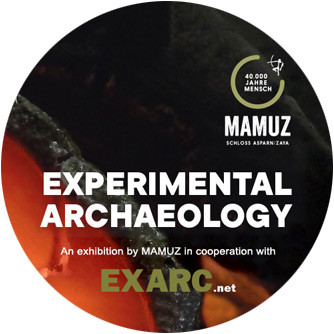
Long time EXARC member MAMUZ Schloss Asparn/Zaya has done something special: with help of EXARC, they put together an international touring exhibition on experimental archaeology.
The exhibition presents exciting and unusual experiments conducted by respected archaeologists from across the globe that have provided revealing insights into the living environments of the ancient world. But can a modern experiment reflect the reality of the past? How is an experiment set up and why is meticulous documentation so important? The exhibition first introduces experimental archaeology as a research method and then presents a broad spectrum of experiments and areas of application.
Archaeology is largely concerned with periods from which neither written nor pictorial sources have survived. Traditional archaeological methods are often inadequate for understanding the way in which archaeological finds, such as tools and structures, were made and used. Only scientific experiments can answer specific questions about the technical possibilities, work processes and craftsmanship of our ancestors. But in order to carry out an experiment it is vital to have a mastery of the tools and materials. Experimental archaeologists therefore require not just historical knowledge, but also practical know-how and excellent manual skills.
The exhibition shows experiments in areas such as ceramic production, wood technology, bronze casting, glass bead making, textile handicrafts, bone working and metallurgy. Experiments also help understand the processes involved with various activities, such as preparing roast pork 8,000 years ago and are used to show how people lived using a reconstructed Viking house.

MAMUZ Schloss Asparn/Zaya is Lower Austria’s competence centre for Prehistory, Historical Archaeology and Experimental Archaeology. The permanent exhibition offers an overview of the cultural history of Eastern Austria from the Palaeolithic to the beginning of the modern era using original exhibits and, in addition, fully functional models of prehistoric residential buildings and workshops from the Stone Age to the Iron Age at the adjacent open-air site.
More information about MAMUZ: https://exarc.net/members/venues/mamuz-at

The exhibition is on display at MAMUZ Schloss Asparn/Zaya until 28 November 2021 following upon which it will be travelling, first stop: the UK. If you are interested in hosting this exhibition, please contact renate.heger@mamuz.at.
| SIZE Exhibition space required: 150–300 m² AVAILABLE from December 2021 on |
25 EXPERIMENTS BY 46 ARCHAEOLOGISTS FROM 11 NATIONS The exhibition presents 25 exciting and innovative experiments conducted by 46 archaeologists from across the globe that have provided revealing insights into the living environments of the ancient world. The exhibition first introduces experimental archaeology as a research method and then presents a broad spectrum of experiments and areas of application. Archaeology is largely concerned with periods from which neither written nor pictorial sources have survived. Traditional archaeological methods are often insufficent for understanding the way in which archaeological finds, such as tools and structures, were made and used. Only scientific experiments can answer specific questions about the technical possibilities, work processes and craftsmanship of our ancestors. But in order to successfully carry out an experiment it is vital to have a mastery of the tools and materials. Experimental archaeologists therefore require not just historical knowledge, but also practical know-how and excellent manual skills. The exhibition shows experiments in areas such as ceramic production, wood technology, bronze casting, glass bead making, textile handicrafts, bone working and metallurgy. Experiments help understand the processes connected to various activities, such as preparing roast pork 8,000 years ago or create comparative data, like on how people might have lived in a Viking house. The exhibition was organised by MAMUZ in cooperation with EXARC, a global network of archaeological open-air museums and experimental archaeologists. OVERVIEW OF THE CONTENTS ON DISPLAY: Introduction / Franz Pieler EXPERIMENTAL ARCHAEOLOGY Introduction / Matilda Siebrecht / Roeland Paardekooper THE MANY FACES OF EXPERIMENTAL ARCHAEOLOGY 1 Sue Heaser EARLY MEDIEVAL GLASS BEADMAKING 2 Danica Staššíková-Štukovská GLASS MELTING EXPERIMENTS IN THE ARCHEOPARK IN HANUŠOVCE NAD TOPĽOU 3 Jannie Marie Christensen MAN AND HOUSE 4 Frances Houston LET’S GET WEAVING! 5 Katrin Kania / Heather Hopkins Pepper MEDDLING METALS? 6 Katrin Kania WHAT MAKES THE YARN? 7 Thomas Rose / Yarden Pagelson / Yuval Goren RECONSTRUCTING THE METALLURGY OF THE CHALCOLITHIC SOUTHERN LEVANT (4200–3800 BCE) 8 Lukas J. Kerbler BLOOMERY FURNACE 9 Michael Konrad A MATTER OF FORM? 10 Johannes Auenmüller / Georges Verly / Frederik W. Rademakers / Florian Téreygeolv CASTING CAT HEADS 11 Nicholas Groat / Lenore Thompson CERAMICS AND SMELTING 12 Anna Kaiser / Boris Dreyer DANUVINA ALACRIS 13 Beate Maria Pomberger HOW WERE GUT STRINGS PRODUCED IN PREHISTORY? 14 Wolfgang F. A. Lobisser WOOD TECHNOLOGY OF THE EARLY NEOLITHIC PERIOD 15 Duncan Keenan-Jones HERO’S AUTOMATA AND DIGITAL EXPERIMENTAL ARCHAEOLOGY 16 Anja Mansrud HOOKED! 17 Magyar Történelmi Íjász Társaság, Gábor Szabó, Zengő Nyíl BRONZE-HEADED ARROWS AGAINST THE IRON GATE 18 Grzegorz Osipowicz BIRCH TAR PRODUCTION IN PALAEOLITHIC AND MESOLITHIC 19 Barbara Horejs / Michael Brandl / Irene Petschko / David Blattner THE PATH TO MAKE A PIG ROAST 8000 YEARS AGO 20 Hans Reschreiter / Wulf Hein / Fiona Poppenwimmer / Rolf Palm / Frank Findeiß / Heather Leach / Christine van der Stege BENDING AND BREAKING 21 Hans Reschreiter / Fiona Poppenwimmer / Daniel Brandner / Max Grabner / Frank Trommer HOW MUCH COPPER AND TIN FOR SALT? 22 Franz Pieler / Karina Grömer / Michael Konrad / Michaela Fritzl LONG TERM EXPERIMENT: MIDDLE BRONZE AGE TUMULUS 23 Michaela Fritzl RITUAL MATTERS 24 Kirsten Mandl / Martin Grassberger AS RED AS BLOOD 25 Fritz Ugrinovits RED AND BLACK |
The bilingual (EN/DE) exhibition catalogue counts 176 pages and can be bought ordered directly from MAMUZ Schloss Asparn/Zaya for 24,95 EUR (excl. P&P) via buchung@mamuz.at. It is also for sale at the museums which host the exhibition.
More information: https://www.mamuz.at/en/exhibitions/schloss-asparn-zaya/6-experimentelle-archaeologie
